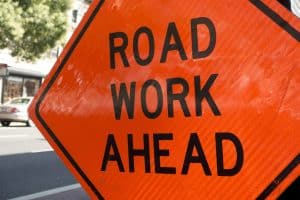Fargo Drivers Beware: The Dangers of Work Zones
 Orange signs on the side of the road typically mean one thing: road work zone ahead. While most drivers believe these signs are there to remind them to slow down and be cautious for the sake of workers’ safety – and, yes, they are – the signs are also intended as a warning for drivers’ own safety. Workers in roadway work zones are at high risk of sustaining an injury or being killed by passing vehicles, but these areas can also pose serious risks for drivers and their passengers.
Orange signs on the side of the road typically mean one thing: road work zone ahead. While most drivers believe these signs are there to remind them to slow down and be cautious for the sake of workers’ safety – and, yes, they are – the signs are also intended as a warning for drivers’ own safety. Workers in roadway work zones are at high risk of sustaining an injury or being killed by passing vehicles, but these areas can also pose serious risks for drivers and their passengers.
In fact, according to the Federal Motor Carrier Safety Administration, each year an average of more than 700 people die in work zones. This is particularly noteworthy now, as the North Dakota Department of Transportation (NDDOT) lists several roadwork projects currently in progress or slated to begin in the Fargo area in 2023. The work includes current and future projects involving the I-29 interchange (exit 69) and 40th Avenue North, the I-94 Maple River Bridge reconstruction, the I-94 east and westbound reconstruction west of West Fargo, tri-level bridge modifications, and University Drive lift station projects.
Whether you are driving a car, an SUV, a pickup truck, a motorcycle, or an 18-wheeler, it is crucial that you exercise additional caution when approaching, driving through, and leaving a work zone. Failure to do so could result in a car accident or a truck accident, either of which could leave you or someone else seriously injured — or worse.
Most common causes of traffic accidents in Fargo work zones
What is it that makes work zones so dangerous? There are several factors, but the slowing of traffic and changes in roadway patterns – when a lane is closed and traffic must shift in response, for example – are two issues that can be problematic if drivers are not paying close attention to the road and all signage:
- Speed. Road signs typically direct drivers to reduce their speed significantly when approaching and traveling through a work zone. Stopped or heavy traffic, rough or uneven surfaces, or debris or other obstructions in the roadway can all impede a driver’s ability to travel through a work zone at a normal rate of speed. Drivers who ignore or fail to notice roadway signage indicating a lower speed limit, and who do not slow down accordingly, can cause serious or even fatal car accidents in work zones.
- Lane pattern changes. These changes are especially dangerous in high-traffic areas, where cars and trucks must merge down to fewer lanes. Drivers of passenger vehicles are often unaware of the unique challenges facing drivers of 18-wheelers and other large trucks. For instance, at up to 80,000 pounds when fully loaded and approximately 35,000 pounds when empty, tractor-trailers require substantially more time and distance to safely stop than a passenger vehicle which typically weighs between 3,000 and 7,000 pounds. Combine this with the many large blind spots on large trucks such as 18-wheelers that significantly reduce the driver’s ability to see both the road and other vehicles through the rearview and side mirrors – tractor-trailers have blind spots along both sides of the truck as well as in the front and back – and the risk of accidents increase when traffic slows and traffic patterns shift due to work zones. With so many large trucks on North Dakota’s roads, particularly oil trucks, it is especially important for drivers of passenger vehicles to stay alert and drive cautiously through work zones.
Other common hazards that may cause car accidents or truck accidents in work zones include:
- Distracted driving. Texting or scrolling through social media; talking on the phone; changing the radio station; eating or drinking; grooming, including applying makeup or shaving; refereeing a disagreement between children or other passengers; even simply carrying on a lively conversation with passengers – any of these activities can be considered distracted driving and may contribute to an accident. This is especially true in North Dakota, which ranks as one of the worst states for distracted driving. While under normal circumstances most drivers are capable of having a casual conversation, taking a sip of water, or quickly changing the radio station without getting into a car accident, driving through a work zone is not “normal circumstances.” Changes to lane patterns, increased traffic, reduced speeds, the potential for debris in the roadway, and uneven or rough road surfaces can all make driving more challenging and require drivers to keep their attention on the road and both hands on the wheel at all times.
- Following too closely. Tailgating is dangerous even under the most ideal driving circumstances. (So, too, is “rubbernecking” at the ongoing construction.) In a work zone it can cause multi-vehicle accidents that result in serious injuries or even fatalities.
- Construction debris in the roadway. Even something as small as a nail can cause big problems. A passenger vehicle that runs over a nail could experience a tire blowout. Depending on the tire, the driver may have difficulty maintaining control of the vehicle, which could result in a crash.
- Uneven roadways or shoulders. When the road surface shifts from smooth and solid to a lower height or a rough surface, the change may be challenging for drivers. Uneven road surfaces can cause tire blowouts, axle damage, or even damage to windshields from loose debris.
Driving safely in work zones
You should always remain alert while operating a motor vehicle – whether it is a passenger car or a tractor-trailer – but this is especially true when you are driving near or through a work zone. From the moment you see those orange signs lining the roadway, it is critical that you give them the attention they deserve. The signs displayed when you are approaching, traveling through, and exiting a roadway work zone will provide vital information, such as warnings about:
- Detours
- Lane changes or closures
- Reduced speed limits
- Road closures
- Rough road
- Shoulder closure
- Workers ahead
These signs may even warn you to “be prepared to stop.” Paying close attention to signage can help ensure you are able to travel safely through a work zone.
What to do if you are in a car accident or truck accident in a work zone
With so many work zones currently in and around Fargo, it is important to know what to do if you or a loved one is involved in a car or truck accident in a work area. Even a seemingly minor accident can cause serious or even life-threatening injuries. Broken bones or soft-tissue damage may seem minor at first, but may require significant or long-term medical care. Burns, traumatic brain injuries, spinal injuries, traumatic amputations, and internal damage all require immediate medical attention and can be lifechanging injuries that leave the victim in need of medical and financial support for the rest of their life – typically well beyond what insurance will cover.
If you or a loved one has been involved in a car or truck accident in a work zone in Fargo or the surrounding area, you should speak with an experienced Fargo car accident attorney as soon as possible. Having the right legal counsel fighting on your behalf can help ensure you receive the compensation you deserve. From our offices in Fargo, Bismarck, and Minot, the knowledgeable personal injury attorneys at Larson Law fight on behalf of accident victims throughout North Dakota. Call us or complete our contact form today to schedule a free consultation. We handle accident cases on a contingency fee basis.

Mark Larson is a Certified Civil Trial Specialist and Certified Civil Pre-Trial Specialist focusing on personal injury, car accidents, wrongful death, and oil field claims. Since 1979, Larson Law has served the injured throughout North Dakota. Read more about Mark V. Larson.
